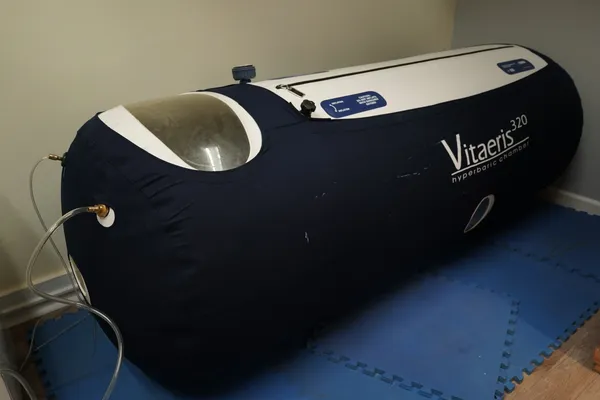Hyperbaric Chamber

Hyperbaric oxygen therapy (HBOT) is well known for treating scuba and deep-sea divers affected by the rapid change in pressure around them. But did you know that HBOT is also used to treat a variety of other health problems?
HBOT involves breathing 100% (pure) oxygen while in a special space called a hyperbaric chamber. The air pressure inside is raised to a level that is higher than normal air pressure. The increased air pressure in the chamber helps the lungs collect more oxygen. Getting more oxygen to the tissues that need it can help the body heal and fight certain infections. We recommend checking with your health care provider before using an HBOT device to make sure you are pursuing the most appropriate care.
prices
1.0 hr. 1 Session = $80.00
Minimum 6 hours in a week of treatment is required.
10 hrs. 7 sessions = $525.00 $75/session
20 hrs. 14 sessions = $980.00 $70/session
40 hrs. 28 Sessions = $1820.00 $65/session
Contact us to book an appointment
For same day and weekend appointments, please call.
What the Studies Say:
Precautions
Hyperbaric oxygen therapy is not for everyone. It should not be used by people who have had a recent ear surgery or ear trauma, a cold or fever, or certain types of lung disease. The most common complication after HBOT is trauma to the middle ear. Other possible complications are eye damage and sinus problems. In rare, severe cases, a person can get oxygen poisoning. This can lead to seizures, fluid in the lungs, lung failure, or other problems. Considering the possible risks and benefits, the decision to use hyperbaric oxygen therapy must be carefully made after a detailed discussion with your healthcare provider.
Do I need 40 sessions?
’40 hour protocol’ is the gold standard for many of the physiological benefits that have been observed with HBOT. However, the actual physiological benefits (for HBOT) can be seen in just a few sessions! Most physiological benefits will begin within the first few sessions of HBOT. It has been well documented that the anti-oxidant and protective role of HBOT is immediate and demonstrated within 24 hours of just one hyperbaric session. Further to this, the anti-inflammatory response is quite also very quick and a strong physiological response has been shown within 4 days of hyperbaric therapy. Many studies have reported HBOT to produce a strong pain-relieving effect after just 5 to 10 sessions. HBOT’s effects on promoting new blood vessel formation (angiogenesis) can take place in just 10 to 20 sessions. From our data, here is a general summary: 1-5 sessions: Improve cellular energy and during this time tissue functioning may be optimized. Those with residual carbon monoxide (ie smokers) or with mild anemia can show immediate benefits with cellular energy. Inflammatory markers can go down considerably and mark the beginning of a natural repair process. 5-10 sessions: Typically used for acute injuries with soft tissue damage, particularly if there is pain involved. 10-20 sessions: More serious acute injuries or chronic injuries. 20-40 sessions: Commonly used for major tissue damages and when new tissue is required (through HBOT’s regenerative stem cell properties).
The FDA has cleared Hyperbaric Oxygen Therapy For the treatment of:
- Air and gas bubbles in blood vessels
- Anemia (severe anemia when blood transfusions cannot be used)
- Burns (severe and large burns treated at a specialized burn center)
- Carbon monoxide poisoning
- Crush injury
- Decompression sickness (diving risk)
- Gas gangrene
- Hearing loss (complete hearing loss that occurs suddenly and without any known cause)
- Infection of the skin and bone (severe)
- Radiation injury
- Skin graft flap at risk of tissue death
- Vision loss (when sudden and painless in one eye due to blockage of blood flow)
- Wounds (non-healing, diabetic foot ulcers)
The absence of an FDA approval does not necessarily mean that utilizing HBOT for the treatment of.
HYPERBARIC THERAPY CAN ALSO BE USED FOR OFF-LABEL
- AIDS/HIV
- Alzheimer’s Disease
- Asthma
- Bell’s Palsy
- Brain Injury
- Cerebral Palsy
- Depression
- Heart Disease
- Hepatitis
- Migraine
- Multiple Sclerosis
- Parkinson’s Disease
- Spinal Cord Injury
- Sports Injury
- Stroke

